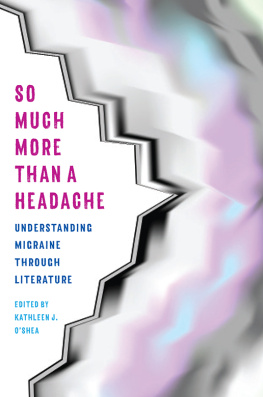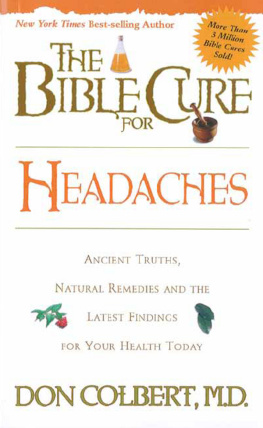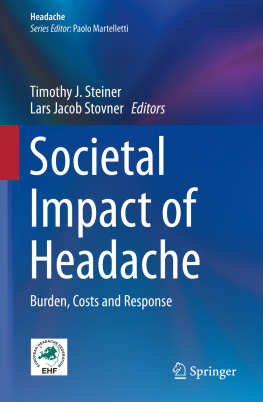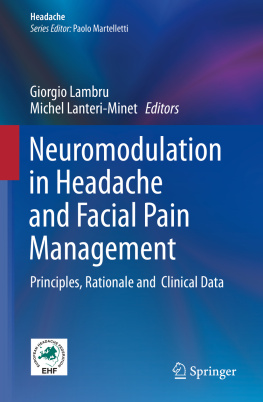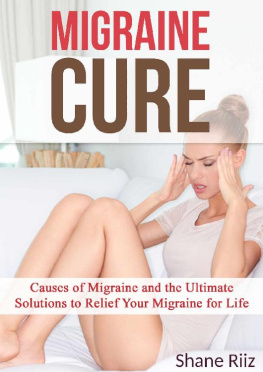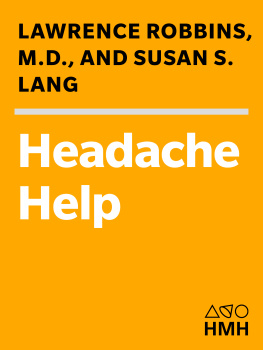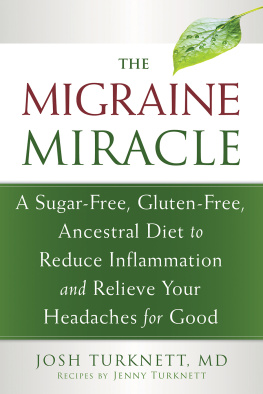
Scribe Publications
HEADACHE
Dr Carole Hungerford became a general practitioner in 1975. After working for five years in London, she has for the last 20 years shared her time between her rural practice in Bathurst, New South Wales, and her practice in eastern Sydney. She has helped educate young graduates for the Royal Australian College of General Practitioners, and she is also a fellow of the Australasian College of Nutritional and Environmental Medicine. Her previous book is Good Health in the 21st Century , which won the Science Writing Award in the 2006 Queensland Premiers Literary Awards. Caroles website is www.carolehungerford.com.
Scribe Publications Pty Ltd
1820 Edward St, Brunswick, Victoria 3056, Australia
50A Kingsway Place, Sans Walk, London, EC1R 0LU, United Kingdom
First published by Scribe 2014
Copyright Carole Hungerford 2014
All rights reserved. Without limiting the rights under copyright reserved above, no part of this publication may be reproduced, stored in or introduced into a retrieval system, or transmitted, in any form or by any means (electronic, mechanical, photocopying, recording or otherwise) without the prior written permission of the publishers of this book.
National Library of Australia
Cataloguing-in-Publication data
Hungerford, Carole, author.
Headache / by Carole Hungerford.
9781922070470 (Australian edition)
9781922247759 (UK edition)
9781925113006 (e-book)
1. Headache. 2. Migraine.
616.8491
scribepublications.com.au
scribepublications.co.uk
Contents
Part I: The Problem of Headache
Part II: Treatment Options
Part III: The Science Behind Headache
Introduction
At one time, people thought that migraine was a disorder all its own and that tension-type headache was totally separate. Now we know that headaches are not all that clear cut.
DOCTOR NINAN MATHEW
This book is all about headache. It is not about the medical emergencies, often referred to as secondary headaches, that present in the emergency department. It is about the headaches that the family doctor sees every day. It is about the headaches that rob individuals of quality of life, and the nation of time lost from work. We regard such headaches as primary headaches.
The spectrum of people who get headaches is wide; it is not easy to predict who will suffer from them. At one extreme are the hardy souls by no means few in number who can barely remember ever having had a headache. The US National Institute of Neurological Disorders and Stroke have evidence that 10 per cent of men and 5 per cent of women dont have a single headache during their entire lives. At the other extreme are those whose lives are dominated by headache. And in between there is a lot of variation concerning who gets headaches and how often they get them. Clearly headache is more than one illness, and it afflicts more than one personality type.
What we do know is that the size of the problem is growing. In this, the second decade of the millennium, it is estimated that approximately 45 million Americans get chronic headache. Thats about one in six people. Of these headaches, 28 million are classified as migraine. The rest are due to the other causes. In the United Kingdom, about 6 million adults suffer from migraine. On any one day, 200,000 people will experience a migraine. Half of them will miss school or work. The cost to the National Health Service for medications and visits to the doctor is estimated at 150 million a year. In terms of time lost from work, the estimate of cost to the UK economy is 2.25 billion, with 5 million working weeks lost each year. Added to this, of course, are the days lost to work as the result of headaches not classified as migraine. In Australia, while no major studies have been undertaken, it is estimated that there are more than 3 million migraine sufferers and more than 7 million sufferers of tension headaches. Twenty-three per cent of households contain at least one migraine sufferer, and the direct and indirect costs of migraine are estimated to be around $1 billion annually.
The World Health Organization has placed migraine among the worlds 20 leading causes of disability. Chronic headaches from other causes simply add to this.
Why are headaches growing in number? Is it that we are exposed to more chemicals than in the past, or that we are eating more processed foods, or that we are working longer hours or a combination of all of these things? We do not yet know the answer, but we do know that it will continue to cost individuals, doctors, and even nations both time and money as people continue to suffer.
This book is not about me, but it would be disingenuous not to tell the story that I know best of all. This book discusses other case histories, using pseudonyms and changing some biographical details to preserve anonymity. I have no such restrictions on my own story.
I am a sufferer of migraine, although it took me many years to realise the full implications of this, and to see the pattern to my headaches.
As a child, I suffered from car sickness, often when my grandmother was in the car. She would sit in the back between my brother and me, and slip us chocolate when our mother was not looking. (There were rules about sweets, which Nanna treated with grandmotherly disdain.) Nanna also wore perfume, with which I had a lovehate relationship. On the one hand, it smelled exotic and pretty; on the other, it gave me a sick feeling, which I would now identify as a migraine aura.
At the age of nine, I had my first experience of migraine. I felt a pain around my face so distinct that you could draw a line around it. I had a dull headache on top of my head, and mild nausea. Once again, poor Nanna was unwittingly the cause. She had given me my first mango. The smell and flavour was sickly sweet and yet enticing, both at the same time. (I probably got some chocolate also.) I ate the fruit, but asked if the mangoes could be kept in another room because I found their smell unpleasant.
A few years later, when I was in high school and just entering puberty, I woke one night and was unable to get back to sleep. My father, who was still up, offered me some rum and milk, his own cure for insomnia (and just about everything else). I went back to sleep quite quickly, but at school the following day. I remember telling my teacher about the peculiar headache I was experiencing. It was all over one side of my head, and again I noticed that the edge of it was sharply defined, as if I could trace a line along the border.
After that, I had a few more migrainous events headaches with features such as visual disturbance, but that stopped short of anything that would be classified as a full-blown migraine. Several times they occurred after eating cashew nuts. I was a serious competitive swimmer, and I began to notice another interesting symptom. As the swimming season wore on and the water got colder, I was developing Raynauds phenomenon. When I was cold, the tips of all of my fingers would become white and bloodless, and eventually this would extend to the entire length of the outer two fingers. I also developed painful chilblains in my toes. Sensitivity to cold, leading to spasm in the tiny blood vessels of the fingers and toes, has a recognised connection to some forms of headache, but of course I did not know that then.
Once I entered medical school, the headaches became more frequent, although they were still reasonably rare. Various things would set them off. Sitting under a flickering fluorescent light in the library was intolerable. Eating dark chocolate or oranges, or drinking red wine, was a disaster. Eating peanuts and cashew nuts was almost as bad. Then, one day, on my way to an exam, I splashed perfume all over myself to put me in a positive mood for the exam. The result was nearly catastrophic. I fought nausea, and had trouble making sense of words in the questions, which ran into one another. I fear that many of my answers must have looked like babble to the examiners. I did get through the exam, but I will never know how.
Next page



